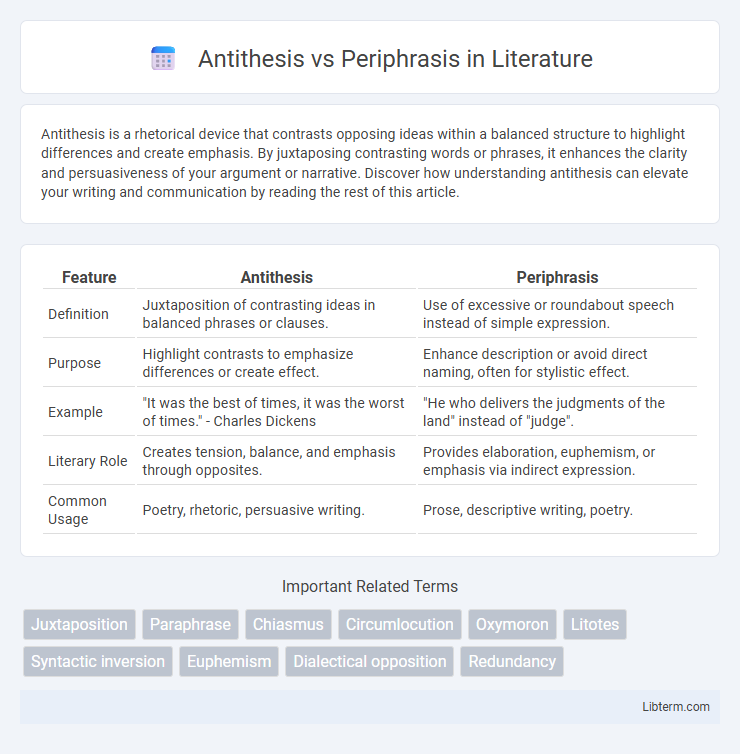Antithesis is a rhetorical device that contrasts opposing ideas within a balanced structure to highlight differences and create emphasis. By juxtaposing contrasting words or phrases, it enhances the clarity and persuasiveness of your argument or narrative. Discover how understanding antithesis can elevate your writing and communication by reading the rest of this article.
Table of Comparison
| Feature | Antithesis | Periphrasis |
|---|---|---|
| Definition | Juxtaposition of contrasting ideas in balanced phrases or clauses. | Use of excessive or roundabout speech instead of simple expression. |
| Purpose | Highlight contrasts to emphasize differences or create effect. | Enhance description or avoid direct naming, often for stylistic effect. |
| Example | "It was the best of times, it was the worst of times." - Charles Dickens | "He who delivers the judgments of the land" instead of "judge". |
| Literary Role | Creates tension, balance, and emphasis through opposites. | Provides elaboration, euphemism, or emphasis via indirect expression. |
| Common Usage | Poetry, rhetoric, persuasive writing. | Prose, descriptive writing, poetry. |
Understanding Antithesis: Definition and Purpose
Antithesis is a rhetorical device that juxtaposes contrasting ideas in a balanced structure to highlight differences and create emphasis. Its primary purpose is to clarify complex concepts by presenting opposing viewpoints or elements side by side, enhancing the impact of the message. Antithesis effectively sharpens the contrast, aiding in persuasion and memorability within speeches and literary works.
What is Periphrasis? Meaning and Examples
Periphrasis involves the use of a descriptive phrase or circumlocution to express an idea instead of a single word, enhancing clarity or style in language. It often substitutes concise terms with longer, more elaborate expressions, such as saying "the father of computers" instead of "Charles Babbage." This rhetorical device enriches communication by adding emphasis, clarity, or a poetic tone to the conveyed message.
Key Differences Between Antithesis and Periphrasis
Antithesis contrasts two opposing ideas within a sentence to highlight their differences, often using parallel structure for emphasis. Periphrasis involves using more words than necessary to express an idea, often to create a formal or elaborate tone. The key difference lies in antithesis's focus on juxtaposing ideas for sharp contrast, while periphrasis emphasizes indirect or extended expression of a concept.
How Antithesis Functions in Rhetoric
Antithesis functions in rhetoric by juxtaposing contrasting ideas within parallel structures to highlight differences and create emphasis, enhancing the argument's clarity and impact. This technique sharpens the contrast between opposing concepts, making the message more memorable and persuasive. Effective antithesis leverages symmetry in sentence construction to balance opposing notions, thereby reinforcing the speaker's intent and engaging the audience intellectually.
The Role of Periphrasis in Effective Communication
Periphrasis enhances effective communication by using indirect and elaborate expressions to clarify complex ideas, adding nuance and emphasis. It allows speakers or writers to avoid ambiguity, soften statements, and convey politeness or formality. Antithesis, in contrast, highlights contrast through concise opposition, making periphrasis essential for subtlety and elaboration in discourse.
Structural Aspects of Antithesis
Antithesis hinges on a parallel structure where contrasting ideas are presented in a balanced, symmetrical format, often using phrases or clauses of similar length and grammatical form. This structural balance enhances the clarity and impact of the opposition, making the contrast more vivid and memorable. The deliberate juxtaposition of syntactically equivalent elements is the defining feature that distinguishes antithesis from other rhetorical devices like periphrasis, which uses indirect or circumlocutory language rather than balanced opposition.
Stylistic Uses of Periphrasis in Literature
Periphrasis, a stylistic device involving the use of excessive or indirect wording to express an idea, enhances literary texts by adding emphasis, creating rhythm, and evoking vivid imagery. Unlike antithesis, which contrasts ideas to highlight differences, periphrasis softens or elaborates meaning, often contributing to a work's tone and style. Classic literature frequently employs periphrasis to introduce formality, irony, or depth, enriching narrative layers and engaging readers through nuanced expression.
Common Examples: Antithesis vs Periphrasis
Antithesis commonly appears in phrases like "It was the best of times, it was the worst of times," demonstrating stark contrasts within a balanced structure. Periphrasis is used in expressions such as "the king of beasts" for lion, adding descriptive elaboration instead of straightforward naming. These rhetorical devices enhance communication by either emphasizing opposition or providing indirect, embellished references.
When to Use Antithesis or Periphrasis in Writing
Use antithesis in writing to create strong contrasts that highlight opposing ideas, emphasizing differences and enhancing rhetorical impact. Employ periphrasis when aiming to add formality, elaboration, or euphemism to your language, making descriptions more vivid or indirect. Choosing between antithesis and periphrasis depends on whether the goal is to sharpen clarity through opposition or to enrich expression through circumlocution.
Impact on Reader: Clarity, Emphasis, and Stylistic Choice
Antithesis sharpens clarity and emphasis by juxtaposing contrasting ideas, making arguments more memorable and impactful for readers. Periphrasis enhances stylistic expression and subtlety by using elaborate or indirect phrasing, which can provide nuance but may reduce immediate clarity. Writers choose antithesis to deliver clear, powerful points, while periphrasis suits contexts demanding sophistication and layered meaning.
Antithesis Infographic

 libterm.com
libterm.com